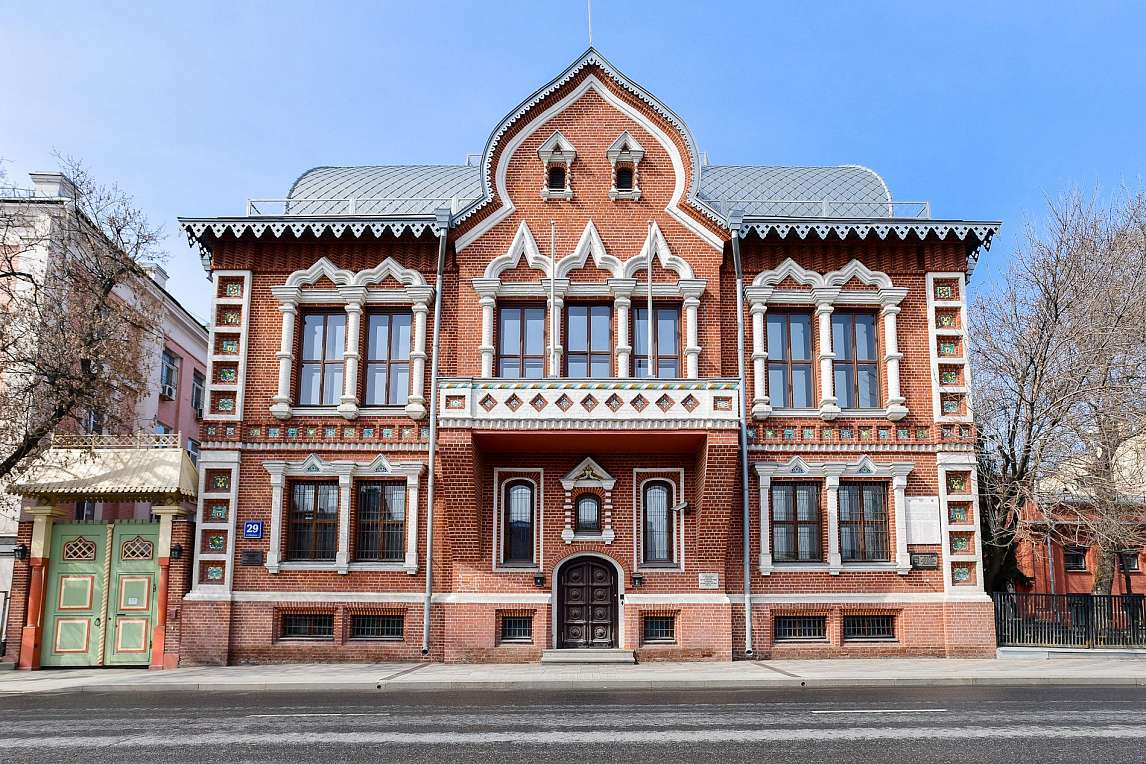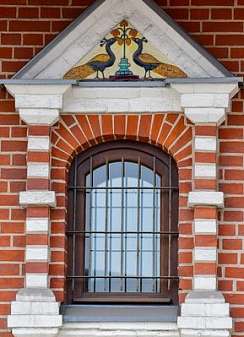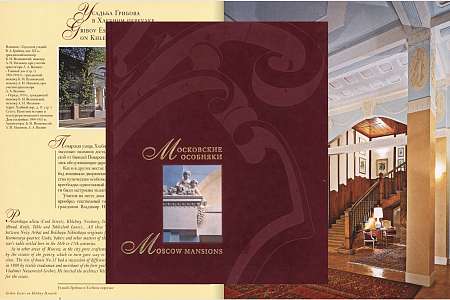



Prechistenskaya Embankment is located on the left bank of the Moskva River in the Khamovniki District. The name dates back to the 18th century and derives from the name of Prechistenka Street. In 1924, it was renamed to Kropotkinskaya Embankment along with the Cathedral of Christ the Savior Embankment. In 1993, the embankment reclaimed its original name.
When walking around these parts, one can hardly fail to notice the red-brick building resembling a fabulous Old Russian terem. This house previously belonged to Ivan Evmenievich Tsvetkov, a patron and collector of fine arts. He worked at the Moscow Land Bank nearly all his life, where he made a brilliant career due to his hard work and profound knowledge of science. Tsvetkov’s life changed after his visit to the Tretyakov Gallery: he dedicated himself to art. The future philanthropist started to collect paintings, watercolors, and even sketches by Russian artists.
Soon, his mansion in Krivoarbatsky Lane became too small for his spawning collection. Therefore, in autumn of 1898, Ivan Tsvetkov acquired a lot near Prechistenka Street, intending to build a new house in the Russian style. He designed the layout all by himself while V. M. Vasnetsov was entrusted with the project preparation and decorative design.
The artist gave his all to this project so the two-story building indeed resembled boyars’ chambers of the 17th century richly decorated with platbands, wide bands of dogtooth brickwork, and tessellated tiles on the pediment and cornices. The interior decorations featured carved wooden chests and benches and massive ceiling chandeliers, accurate replicas of heavy Novgorod church chandeliers of Ivan the Terrible’s era.
The gallery proper was the centerpiece of the house. It displayed paintings by Anton Losenko, Vladimir Borovikovsky, Vasily Tropinin, Karl Bryullov, Pavel Fedotov, Vasily Perov, Ivan Kramskoy, Vasily Polenov, Ilya Repin, Vasily Surikov, Isaac Levitan, etc. Along the walls glass display cases stood with watercolors and sketches. Many eminent persons visited the house on Prechistenskaya Embankment, including, on one occasion, Emperor Nicholas II in person.
Ilya Repin’s wife, writer Natalia Nordman-Severova, described her impressions after her visit to the gallery, “We are approaching the most charming manor built following Vasnetsov’s design. It has serene, balanced proportions, a nice Old Russian style, decorations, and maiolica friezes. I. E. Tsvetkov built this house solely for his art collection. Both light and room layout – everything serves his concept... We are ascending the wide staircase. The lobby walls are covered in paintings by Russian artists. The whole parlor is, too. The walls are lined with display cases with drawings”.
In 1909, the art collector donated his house and the gallery to the City of Moscow, preserving his right to reside there, renovate it as deemed necessary, and add to the collection.
After Tsvetkov’s death in February 1917, the house was renovated and turned into a museum for good. For several years, the manor used to be the Tretyakov Gallery branch, however, later the collection ceased to exist as a whole: some paintings were donated to provincial museums, about a hundred paintings and drawings remained in Moscow.
However, a few decades later the building became famous again: during World War II it used to accommodate the French military mission which had to muster army units that, according to an agreement between the Allies of World War II, were assembled in the USSR to fight German invaders. Among those was the Normandie-Niemen Fighter Squadron, which later became a Regiment. UpDK (now GlavUpDK under the MFA of Russia) took over the old mansion in the late 1940s; since then and until the very recent time, it served as the French Military Attaché’s personal residence.

The house was well-preserved and matched the initial architect’s design; therefore, the 2016 GlavUpDK restoration project focused on façades and roofing only.
The front-side wall brickwork was repaired and partially replaced; all mortar joints were cleaned of multilayered residue and injected with grout. The brickwork decorations were re-painted according to historical photos. The framing of the entrance, the arch, the inner surface of the porch parapet brickwork, the inner surface of the balcony parapet were re-plastered and repainted.
Restoration of glazed tiles started immediately upon completion of the brickwork repair and seasonal drying of the façades. Several missing and badly damaged glazed tiles were recreated as per available samples; the remaining broken fragments and glaze were cleaned on the spot, preserved, and supplemented. At the final stage, protective varnish was applied to the restored ceramics.
The galvanized roof tiles were replaced with titanium-zinc ones. The same durable modern material was used to produce a carved metal cornice running along the roof overhang and for the missing ridge end piece over the chimney bonnets. Besides, rainwater pipes and heads and missing grilles on basement windows were reproduced.
Thanks to the restoration works, the joinery of external windows and dormer windows was restored. Front and backyard façade porch areas were refitted with natural stone. The wooden entrance was re-installed per archive documents. The late iron gate was removed and the brick fence, including the part running along Kursovoy Lane, was repaired. Like before, the main façade has commemorative plaques in honor of Ivan Tsvetkov and fallen pilots of the Fighter Squadron Normandie-Niemen.